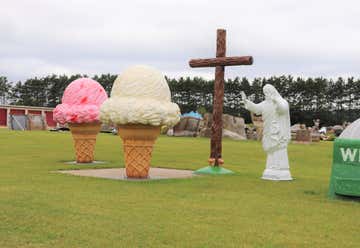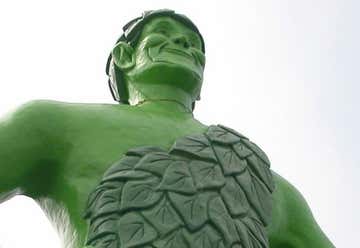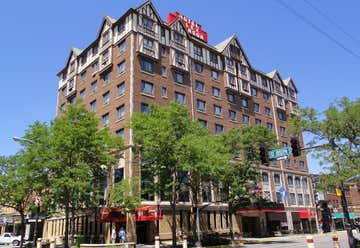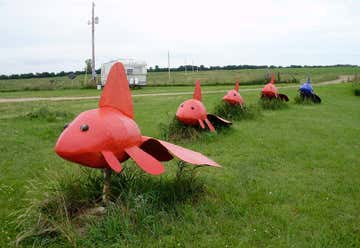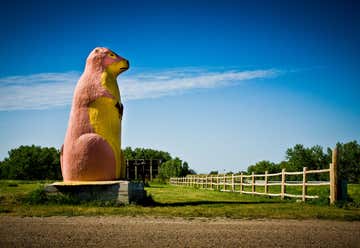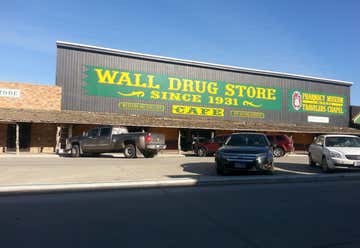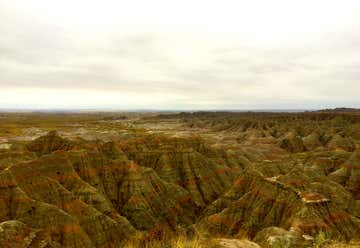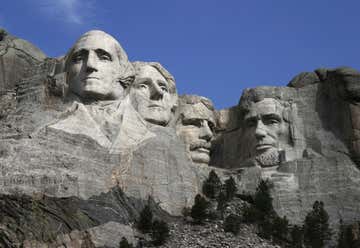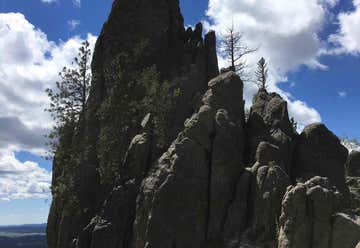Madison, Wisconsin, United States
Date:
Date:
Have you ever wanted to feel incredibly small? Do you love vegetables? Is your favorite color green? Are you trying to convince children that vegetables make you big and strong? All great reasons to stop and see this Jolly Green Giant. Personally, I love Jolly Green (I even made a Halloween costume of our beloved giant that has been recycled by friends and family multiple years.) Honestly, it's a GIANT, 55-foot-tall, bright green statue, and if you're passing through the area definitely make a quick detour to stretch your legs and snap some photos.
Date:
Date:
Porter Sculpture Park is located just off Interstate 90 in Montrose, South Dakota (about 25 miles west of Sioux Falls, on the eastern edge of McCook County). It is on the South Dakota Drift Prairie. Many of the sculptures, in the style of industrial art, were made with scrap metal, old farm equipment, or railroad tie plates. The largest sculpture in the park is a 60-foot-tall (18 m) bull head. This sculpture took three years to build, weighs 25 tons, and is equal in size to the heads of Mt. Rushmore. Everyone will enjoy the porter Sculpture Park - people who love art and entertainment and those that don't! * Over 40 sculptures * A great place to walk your dog * Kids 12 and under free! * 60 foot Bull’s Head Sculpture * Take a walk inside the Bull’s Head * As seen on PBS, CBS – Midwest and International TV * Handicapped accessible with courtesy golf cart * Easy access off I-90 – RV’s welcome * Guided tours with sculptor included * Sculptures also on display at 13th and Phillips Downtown Sioux Falls
Date:
The World’s Only Corn Palace is Mitchell’s premier tourist attraction. Some 500,000 tourists come from around the nation each year to see the uniquely designed corn murals. The city’s first Corn Palace was built as a way to prove to the world that South Dakota had a healthy agricultural climate. Eight years before the turn of the 20th century -1892- when Mitchell, South Dakota was a small, 12-year-old city of 3,000 inhabitants – the WORLD’S ONLY CORN PALACE was established on the city’s Main Street. During its over 100 years of existence, it has become known worldwide and now attracts more than a half a million visitors annually.
Date:
Date:
Nestled along the Missouri River in Chamberlain and Oacoma, SD, Al's Oasis has historically been the premier resting stop for travelers along Interstate 90 (I-90). Here at Al's Oasis we offer bus tour groups, vacationing families, tourists, and lone travelers more than just great food, lodging and shopping. We offer them an escape from their travels. We still have our delicious 5¢ coffee, which always comes with a free smile. Al's Oasis, still a family run business, prides itself on making a fun, convenient, and relaxing stop for you and your family.
Date:
Surrounded by an actual prairie dog colony, this concrete giant towers 12 ft. over its little friends at a whopping 6 tons. The attraction is free, and for $.50 you can buy peanuts at the Ranch Store Gift Shop to feed the (in comparison) teensy prairie dogs of the non-concrete variety.
The massive pink and ocher mascot to the colony below has been watching over this little corner of the Badlands for over 50 years, and despite a little weather wear and tear, shows no sign of going anywhere anytime soon.
Date:
One of the world’s most well-known tourist attractions, it’s hard to believe Wall Drug Store got its start with something many wouldn’t even turn their heads at today … the promise of free ice water. But in fact, the Husteads turned free ice water into a million-dollar idea with a little determination, quick thinking and a lot of signs.
Signs with catchy jingles like “Get a soda . . . Get a root beer . . . turn next corner . . . Just as near . . . To Highway 16 & 14. . . Free Ice Water. . . Wall Drug” drew weary travelers into the small-town drug store to enjoy a refreshing break. Today, more than 2 million visitors a year stop at the popular roadside attraction for a meal or activity, 5 cent coffee, and ice water – which is still free.
Located in Wall, South Dakota, Wall Drug has always been a popular stop on the road to the more populated areas like Mount Rushmore or Rapid City. As a matter of fact, when the United States Air Force operated the Minuteman missile silos east of Wall, the Hustead family offered free coffee and donuts to the service personnel as they traveled to and from Ellsworth Air Force Base near Rapid City. Wall Drug honors the men and women in the armed services by providing them free coffee and donuts to this day.
Date:
How did it come about that there is a stave church in the Black Hills of South Dakota, thousands of miles from the land where this type of architecture and construction originated? It is the result of a dream of one man and the generous support of another... Rev. Harry R Gregerson and his WifeIn the 1960's, the originator and preacher of the Lutheran Vespers radio hour, Dr. Harry R. Gregerson, was looking to expand the scope of his popular radio ministry. As his dream took shape, Dr. Gregerson realized there was the perfect location for his facility right in his own state of South Dakota: the Black Hills. The Black Hills are a vaction destination for people from all over the world. The Chapel was to draw people to it and the Hills was the perfect setting to accomplish this goal. It was the Rev. Conrad Thompson who suggested they build a Stave Church (Stavkirke). Rev. Thompson had spent time in Norway and was familiar with Stave Churches. After careful consideration it was decided to build a Norwegian church on the edge of South Dakota. The chapel is an exact replica of the famous Borgund stavkirke, of Laerdal, Norway. The Borgund stavkirke was built around the year 1150 and is considered the most completely preserved stave church still standing in Norway. The Norwegian Department of Antiquities graciously provided a set of blueprints of the Borgund church to be used in the construction of the Chapel in the Hills. All the general construction was done by a local construction company and other contractors. The woodcarvings are the result of a combined effort by Mr. Erik Fridstrom, one of Norway's best woodcarvers, and a local rapid City resident, Mr. Helge Christiansen. Also, to serve as a visitor center and offices for Lutheran Vespers, an authentic grass-roofed "stabbur," or store house, was built in Norway, shipped to Rapid City, and reassembled on the grounds. In addition to the chapel and stabbur, two residences were constructed on the grounds, a parsonage and caretaker's cabin. Financing for the Chapel came from a generous donation by a local banker, Arndt E. Dahl. Mr. Dahl's parents were Norwegian immigrants and his father was a Lutheran pastor in the Dakotas. Mr. Dahl wanted to build a memorial to his parents and support Lutheran Vespers.The Chapel in the Hills was dedicated on July 6, 1969, and it served as the home of Lutheran Vespers until 1975 whem the radio program was moved to Minneapolis home of the American Lutheran Church at the time. At that time a non-profit corporation took over operation of the Chapel in the Hills and operates it to this day. A number of Pastors were called to the Chapel and a resident Pastor served the Chapel until 2004. At that time it was decided to hire a manager and use local Pastors serving Lutheran churches in the Rapid City area to preside over the Vesper services and weddings. Today the Chapel sees 20,000 to 25,000 visitors ayear and hosts over 100 weddings each year along with renewal of vows, baptisms, and memorial services
Date:
The rugged beauty of the Badlands draws visitors from around the world. These striking geologic deposits contain one of the world’s richest fossil beds. Ancient horses and rhinos once roamed here. The park’s 244,000 acres protect an expanse of mixed-grass prairie where bison, bighorn sheep, prairie dogs, and black-footed ferrets live today.
Date:
The Mount Rushmore National Memorial is a sculpture carved into the granite face of Mount Rushmore near Keystone, South Dakota, in the United States. Sculpted by Danish-American Gutzon Borglum and his son, Lincoln Borglum, Mount Rushmore features 60-foot sculptures of the heads of four United States presidents: George Washington, Thomas Jefferson, Theodore Roosevelt and Abraham Lincoln. The entire memorial covers 1,278.45 acres and is 5,725 feet above sea level. South Dakota historian Doane Robinson is credited with conceiving the idea of carving the likenesses of famous people into the Black Hills region of South Dakota in order to promote tourism in the region. Robinson's initial idea was to sculpt the Needles; however, Gutzon Borglum rejected the Needles site because of the poor quality of the granite and strong opposition from environmentalists and Native American groups. They settled on the Mount Rushmore location, which also has the advantage of facing southeast for maximum sun exposure. Robinson wanted it to feature western heroes like Lewis and Clark, Red Cloud and Buffalo Bill Cody but Borglum decided the sculpture should have a more national focus, and chose the four presidents whose likenesses would be carved into the mountain. After securing federal funding, construction on the memorial began in 1927, and the presidents' faces were completed between 1934 and 1939. Upon Gutzon Borglum's death in March 1941, his son Lincoln Borglum took over construction. Although the initial concept called for each president to be depicted from head to waist, lack of funding forced construction to end in late October 1941. The U.S. National Park Service took control of the memorial in 1933, while it was still under construction, and has managed the memorial to the present day. It attracts nearly three million people annually. National Treasure 2 might have been a complete fabrication of American history, but Nicolas Cage was right about one thing: there's a secret room hidden away in Keystone, South Dakota's Mount Rushmore.. and it's filled with awesome stuff!
Date:
Deemed “impossible” to construct by its critics, Needles Highway—a National Scenic Byway—was completed in 1922 and includes 14 miles of sharp turns, low tunnels and impressive granite spires. The road lies within the 73,000 acre Custer State Park, just 30 miles south of Rapid City.
Date:
The clear mountain waters are inviting, and the open ranges are waiting to be discovered. Bring your family to Custer State Park, and let yourself run wild.Custer State Park in the Black Hills encompasses 71,000 acres of spectacular terrain and an abundance of wildlife. Within the park, you'll discover a world of adventure! A herd of 1,300 bison roams freely throughout the park, often stopping traffic along the 18-mile Wildlife Loop Road. The herd is one of the largest publically-owned herds in the world.Bison can weigh as much as 2,000 pounds. Historically, the animal played an essential role in the lives of the Lakota (Sioux), who relied on the "tatanka" for food, clothing and shelter.Besides bison, the park is home to wildlife such as pronghorn antelope, mountain goats, bighorn sheep, deer, elk, wild turkeys, and a band of friendly burros. Custer State Park boasts several scenic drives that explore the diversity of the area. From the granite spires of Needles Highway to the bison along WIldlife Loop Road.

